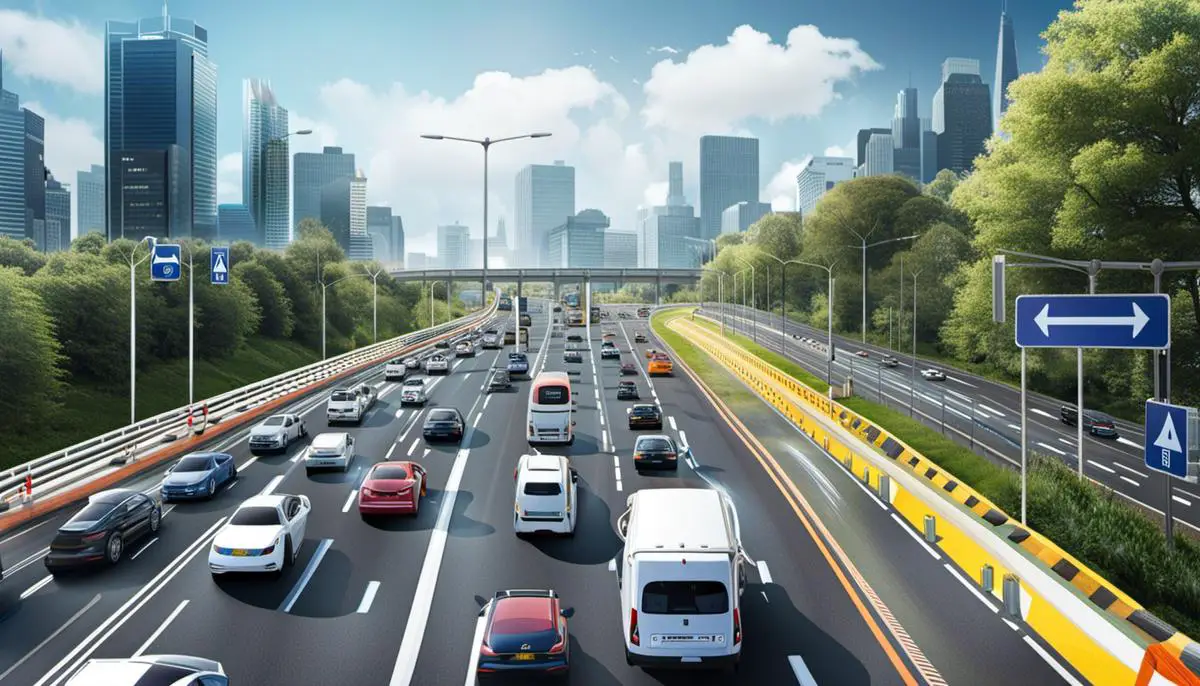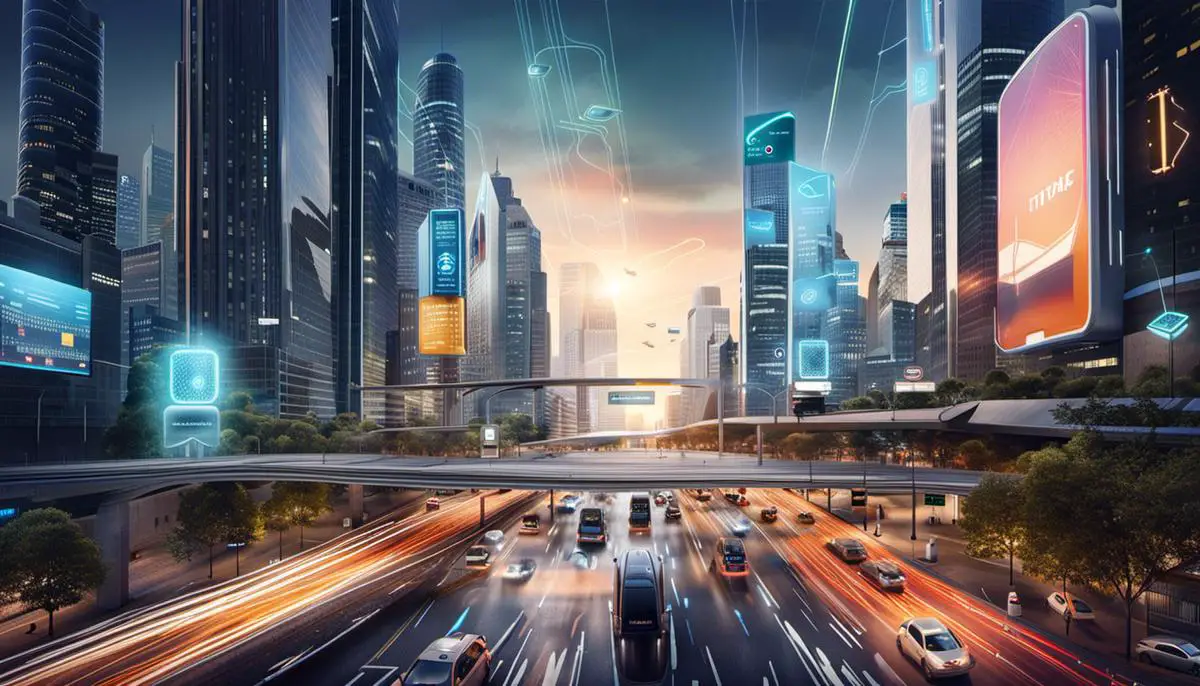Harnessing AI for Traffic Management: A Novel Perspective
Imagine a future where artificial intelligence (AI) controls traffic, optimizes signals, predicts congestion, and enhances overall road safety. That future isn’t as far off as one might think. As we journey into the promising world of AI and its potential employment in traffic management, we will illuminate the concepts and intricacies of AI, its general use cases and more specifically, its applications in traffic systems. Whether it’s leveraging real-time data for traffic signal optimization or implementing intelligent traffic systems, AI’s intervention can drastically alter the way we perceive and deal with traffic. Despite its promising potential, the path to widespread AI integration in traffic management is not devoid of challenges. These must be contended with to comprehensively understand and fully harness AI’s capabilities for creating smarter, safer, and more efficient traffic systems.
Understanding AI and its Applications in Traffic Management
Understanding Artificial Intelligence: An Overview
Artificial Intelligence (AI) is the capability of a computer or a machine to mimic intelligent human behavior. It includes aspects such as machine learning, where machines learn and improve from their experiences, and natural language processing, where they communicate and respond like humans. Over the past few years, AI has evolved drastically, moving from theory and laboratory experiments to real-world applications in various industries. Initially, AI was modeled on human intelligence, attempting to simulate cognitive abilities, but it has now moved towards achieving superhuman efficiency at specific tasks.
General use cases of AI spread across various sectors like healthcare, where AI can help with disease diagnosis and drug discovery; finance, where AI can assist with fraud detection and credit scoring; and retail, where AI can help enhance customer experience through personalized recommendations.
AI in Traffic Management: Breaking Down the Concept
AI has substantial applications in traffic management as well. It uses a variety of algorithms and data analysis to assist in improving traffic flow, predicting traffic congestion, and enhancing overall road safety. Its advanced computational capabilities make it possible to analyze vast amounts of data coming from various traffic components like vehicles, traffic signals, and pedestrians, and make informed decisions to enhance traffic conditions.
Improving Traffic Flow with Artificial Intelligence
One of the primary applications of AI in traffic management is improving traffic flow. Traditional traffic light timings often lead to congestion as they follow pre-set times and do not adapt according to the volume of traffic. This problem is addressed using AI and Machine Learning, which allows traffic lights to dynamically adjust their timings based on real-time traffic conditions. By analyzing the data from traffic cameras and in-road sensors, AI algorithms can predict the expected traffic volume and adjust the signal times, hence, improving the overall traffic flow.
Predicting Traffic Congestion: AI to the Rescue
AI also plays a significant role in predicting traffic congestion. By analyzing patterns from historical traffic data, weather conditions, and ongoing city events, AI algorithms can predict high congestion times and areas. Advanced AI systems can also factor in real-time data from connected vehicles or mobile applications to make more accurate predictions. This information is helpful for city officials to plan traffic management strategies and for commuters to adjust their travel routes and times.
Enhancing Safety and Reducing Emissions through AI
Apart from improving traffic flow and predicting congestion, AI in traffic management also enhances safety and helps to reduce emissions. AI can predict potential accident hotspots by analyzing past accident data. City officials can then address these issues proactively thus, avoiding accidents and enhancing road safety. Furthermore, AI can also help reduce emissions. By improving traffic flow and reducing congestion, AI helps reduce the time vehicles spend idling on roads, thus reducing fuel consumption and subsequently greenhouse gas emissions.
Summary
Over time, artificial intelligence has become a cornerstone in traffic management, demonstrating its vast potential. With the capability to predict and automate, AI not only enhances the efficiency of traffic systems but also increases safety measures and environmental considerations. This technological transformation is stage-setting for the emergence of future-generation intelligent traffic management systems.

Role of AI in Traffic Signal Optimization
Incorporation of AI in Traffic Signal Optimization: A Pioneering Technological Shift
In multiple arenas, artificial intelligence (AI) has illustrated its significant capabilities and traffic management is no exception. The incorporation of AI in traffic signal optimization has marked a revolutionizing shift. By simplifying urban mobility and decreasing traffic congestion, AI has emphasized its indispensable role in this domain.
Making a Positive Impact on Urban Mobility
With growing urbanization, cities face the difficult task of managing busy intersections and major roadways during peak hours. AI, however, is changing the game. Its application for traffic signal optimization directly impacts traffic flow, reducing long queues and wait times at traffic signals. It might even optimize the allocation of green waves, which would ensure consecutive green signals for vehicles moving at a certain speed, promoting fluidity and commuting speed.
AI’s role in traffic management extends beyond signal optimization. It assists in predicting congestion and proactively counteracting bottlenecks before they cause gridlock. AI can analyze shifts in traffic patterns over time, which aids city planners in making informed decisions on road infrastructure and traffic rules.
Reducing Carbon Emissions and Fuel Consumption
One of the less direct, yet equally important benefits of using AI in traffic signal optimization, is its potential impact on the environment. Smoother traffic flows resulting from optimized traffic signals can lead to a reduction in fuel consumption. This is because vehicles won’t idle as much at traffic signals. Less idling times can mean fewer carbon emissions released into the atmosphere from vehicles, aligning with global pursuits to combat climate change.
Safety on the Roads
AI’s use in traffic management also has potential safety implications. By understanding patterns in vehicle movement, AI can help prevent accidents by predicting potential collision scenarios and adjusting traffic signals in response. As a real-time data processing technology, AI holds great promise in this area, promising safer roads for everyone.
Challenges and Future Developments
Despite its vast potential, AI in traffic signal optimization comes with challenges. Data privacy issues, high implementation costs, the need for updated infrastructure are some factors that may impede its universality. However, strengthening the legality surrounding data protection and continually improving AI algorithms can alleviate some of these concerns.
Understanding the Impact of Artificial Intelligence on Traffic Management
Artificial intelligence (AI) has been leaving profound impacts on different facets of our lives, one of the most transformative ones being traffic management. The blend of advanced technology with road infrastructure is an exciting space, wherein AI is showing remarkable potential to change our commuting experiences. As AI continues to evolve, its integration with traffic management is set to further improve urban life’s quality, offering a more efficient and less congested commute for us all.

AI-Powered Intelligent Traffic Systems: Case Studies
The Story of AI Revolutionizing Traffic Management in Pittsburgh, USA
A standout example of the powerful role AI can play in traffic management comes from Pittsburgh, in the United States. Carnegie Mellon University’s Traffic21 Research Institute developed an AI-powered traffic management system for the city, named Surtrac. This pioneering system leverages AI technology to optimize traffic signals in real-time, using cameras and radar sensors to detect vehicles and pedestrians and correspondingly adjust signal timings. As a result, traffic lights no longer adhere to a preset schedule but instead dynamically adapt to actual traffic conditions. The breakthrough has led to a considerable decrease in wait times at traffic lights, down by 40%, and shorter travel times by 25%. For environmentally conscious commuters, it’s noteworthy that this system has brought about a 21% drop in vehicle emissions, proving its efficiency not just for easing traffic congestion but also in reducing the carbon footprint.
China’s Intelligent Traffic Systems
Another noteworthy case is in China, where the government deployed AI-powered traffic management systems in multiple key cities to manage the increasing vehicular traffic. These include vehicle recognition software that can spot violations and automatically send penalties to the vehicle owner, and AI-traffic signals that adjust according to the real-time vehicle flow. One such system developed by Alibaba reduces congestion by predicting traffic flow and adjusting signal timings accordingly, leading to significant reductions in waiting times and emissions.
AI in Traffic Management in Milton Keynes, UK
In the UK, the small city of Milton Keynes has been leading the country in AI implementation in traffic management. The city partnered with Vivacity Labs to install over 2,500 sensors around its road network, using AI technology to monitor traffic and pedestrian behavior in real time. Information obtained from these sensors is used to optimize traffic light signal timings, improving efficiency in transportation and reducing congestion during peak hours.
Singapore’s Smart Traffic Management System
Singapore is also setting benchmarks in AI-powered traffic systems. One of the many initiatives includes the use of AI in Intelligent Transport Systems (ITS). For instance, the Expressway Monitoring and Advisory System (EMAS) uses AI to predict and manage real-time traffic situations, send out alerts about possible congestion, and reroute traffic to less congested roads. It has played a significant role in easing the city’s traffic problems while increasing safety.
By delving into real-world case studies, it’s apparent just how fundamental a role artificial intelligence plays in rewiring the traditional landscape of traffic management. This is made possible through machine learning algorithms and predictive modeling that adapt to dynamic traffic conditions in real-time. The result? An immense enhancement in traffic flow, alongside a notable reduction in congestion and pollution. This snapshot of advancements only hints at the far-reaching potential artificial intelligence contains for reforming traffic management.

Challenges in Implementing AI in Traffic Management
The Financial Implications of Implementing AI in Traffic Management
However, one should note that the fusion of artificial intelligence with traditional traffic management systems may come with a high price tag. It’s not just about the physical integration – AI implementations are based on high-end tools and software that can significantly inflate the initial purchasing cost. But it doesn’t stop there. The added costs of training staff, managing operational demands, and regular system updates can significantly add to the overall investment. Moreover, the processing and storing of the copious quantities of data required for efficient AI systems also contribute to the overall expense.
Data Privacy Concerns in AI-powered Traffic Management
Privacy is another major concern when implementing AI in traffic management. The surveillance cameras and sensors that make up intelligent traffic management systems need to collect and process large amounts of data, including citizens’ personal and location information. Therefore, there’s an inherent risk of misuse or unauthorized access to personal data, leading to potential privacy infringements.
Technological Limitations of AI in Traffic Management
AI in traffic management also faces considerable technological challenges. For instance, the quality and reliability of data used by AI systems can sometimes be problematic. If the data fed into the AI system is incorrect, incomplete, or biased, it can lead to incorrect predictions or decisions. Additionally, AI algorithms depend heavily on the specificity and reliability of the data they receive. Traffic conditions can change rapidly, presenting challenges as the AI must adapt and learn from constantly shifting dynamics.
Need for Regulatory Frameworks in AI-Driven Traffic Management
Adequate, robust regulatory frameworks are necessary for the successful implementation of AI in traffic management systems. These frameworks need to govern data privacy, AI operation standards, and liability in the event of AI-induced accidents or errors. But establishing these guidelines can be challenging due to the rapidly changing nature of AI technology, the cross-jurisdictional management of roads, and the differing perspectives of stakeholders across the public and private sectors.
Overcoming the Hurdles in AI Implementation
In spite of numerous challenges, several solutions exist to conquer them. Monetary limitations can be tackled by pooling resources from government bodies and private sector partners to invest in AI technology, as well as considering cloud computing as an efficient solution for data storage and processing requirements.
Privacy worries can be mitigated by establishing strong data protection laws and well-defined protocols for data access and sharing. In this process, it is essential to anonymize data to safeguard individual privacy.
Technical constraints can be dealt with by enhancing data quality and utilizing complex machine learning algorithms capable of handling sudden changes. The AI systems must undergo regular training and updates to maintain their efficiency.
The provision of regulatory frameworks can be addressed by involving a variety of stakeholders like government agencies, private sector companies, and the general public in policy-making. In collaboration, these parties can formulate equitable, realistic regulations that catalyze innovation and guard the interests of everyone involved.
In summary, even though the use of AI in traffic management faces diverse challenges, a number of practical solutions can be adapted to resolve each one. By employing the right tactics, AI can drastically transform the realm of traffic management and urban transport.

Future of AI in Traffic Management
Current Utilization of Artificial Intelligence in Traffic Management
Today, Artificial Intelligence (AI) has become a cornerstone of advanced traffic management systems to combat the debilitating issues urban centres encounter, such as overwhelming traffic jams, road accidents, and sub-optimal scheduling of public transport. AI achieves this by leveraging algorithms and machine learning procedures to scrutinize traffic data, allowing traffic systems to adapt in real-time by altering signals, routes, and other components. This game-changing technology can also anticipate traffic flow and identify irregular situations, facilitating immediate mitigation of any disruptions.
Advanced Traffic Management Systems and AI
Advanced Traffic Management Systems (ATMS) use AI to monitor and control traffic signals in a coordinated manner, thus reducing congestion and improving flow. These systems can adjust signal timings based on real-time traffic conditions, effectively responding to unexpected events like accidents or road closures. For instance, if a road is closed due to an accident, the system can prompt an announcement warning nearby drivers and suggesting alternate routes to bypass the incident. With the aid of AI, ATMS can reduce travel times, increase road capacity, and improve safety.
Internet of Things (IoT) and AI
Adding another layer of complexity and functionality, the Internet of Things (IoT) is bringing interconnected devices into the mix. In the field of traffic management, IoT devices such as sensors, cameras, and connected vehicles can collect a vast amount of traffic data. AI analysis of this data can be used to predict traffic flow, detect incidents, and improve overall traffic management strategies. The fusion of AI with IoT extends the potential for automated incident detection, emergency vehicle preemption, and smart traffic signals that can adapt to real-time conditions.
AI in Public Transportation
AI can also improve the efficiency and reliability of public transit systems by optimizing schedules and routes based on traffic conditions and passenger demand. Real-time data allows AI systems to dynamically allocate resources, manipulate routes, and manage schedules. This can result in not only a more efficient transit system, but also a better user experience for passengers.
The Future of AI in Traffic Management
The future of AI in traffic management looks promising, with several emerging trends becoming apparent. The integration of AI with other technologies like 5G, Big Data, and Autonomous Vehicles is expected to revolutionize traffic systems further. For example, Autonomous Vehicles guided by AI will be capable of communicating with each other and the infrastructure, potentially reducing traffic congestion and accidents.
With existing technologies, a digital replica of a city’s traffic system can be created, enabling traffic managers to forecast scenarios and formulate effective strategies. Future traffic systems equipped with AI might also be able to respond to traffic changes in real-time, making traffic management more proactive than reactive.
Moreover, AI has the potential to improve transportation equity by ensuring public transit resources are distributed efficiently, meeting the needs of all community members. By predictively analyzing demand and adjusting services accordingly, transit agencies can better serve areas with varying levels of access to transportation.
Overall, the future of AI in traffic management signals a shift toward smarter, more responsive, and efficient systems, empowering cities to achieve better mobility and improved quality of life for its citizens.

Navigating through this discourse, we delved into the vast prospects of AI in traffic management, conferred with real-world applications, and faced head-on its attendant challenges. As we anticipate the future of AI in managing traffic systems, it’s crucial to embrace evolving technologies like the Internet of Things (IoT), layer on top the prowess of AI, and leapfrog towards creating smarter traffic systems. The road to a future where AI dominates traffic management may be challenging and complex, but the potential benefits of increased safety, reduced emissions, and enhanced efficiency affirm the journey’s value. As we continue in this direction, let us remember, every major advancement was once an idea, every revolution was once a vision. So, let us envision – and create – a traffic-managed world enhanced by artificial intelligence.
